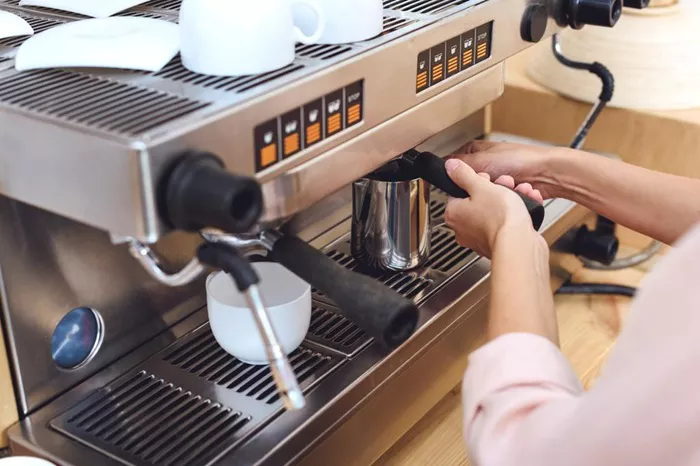An automatic coffee machine is a modern appliance designed to brew coffee with minimal human intervention. Unlike manual methods (such as pour-over or French press) or semi-automatic espresso machines, automatic coffee machines handle most of the brewing process themselves. They grind coffee beans, measure the right amount of water, control brewing temperature, and even dispose of used coffee grounds—all at the push of a button.
These machines are popular in homes, offices, and cafes because they provide convenience, consistency, and high-quality coffee. In this article, we will explore how automatic coffee machines work, their different types, key features, advantages, and how to choose the best one for your needs.
How Does an Automatic Coffee Machine Work
Automatic coffee machines simplify the coffee-making process by automating several steps:
Grinding the Coffee Beans
The machine has a built-in grinder that crushes whole coffee beans into fine or coarse grounds, depending on the selected brew type. Freshly ground coffee ensures better flavor compared to pre-ground coffee, which loses aroma over time.
Measuring Coffee and Water
The machine doses the right amount of coffee grounds based on the selected cup size (single, double, or large mug). It also controls the water volume to maintain the perfect coffee-to-water ratio.
Heating the Water
An internal heating system brings water to the ideal temperature (usually between 90°C and 96°C / 195°F–205°F) for extraction. Proper temperature is crucial—too hot, and the coffee tastes burnt; too cold, and it will be under-extracted and weak.
Brewing the Coffee
Hot water passes through the coffee grounds under pressure (for espresso) or via drip (for regular coffee). The machine controls brewing time to ensure balanced flavor extraction.
Dispensing the Coffee
The brewed coffee flows into a cup or carafe. Some machines also froth milk automatically for cappuccinos or lattes.
Disposing of Used Grounds (in Some Models)
Fully automatic machines eject used coffee grounds into a waste container, reducing cleanup.
Types of Automatic Coffee Machines
There are several types of automatic coffee machines, each suited for different preferences:
Fully Automatic Espresso Machines
These machines handle everything: grinding, tamping, brewing, and sometimes milk frothing. Best for espresso lovers who want convenience without manual work.
Examples: Jura E8, De’Longhi Magnifica.
Super-Automatic Coffee Machines
Similar to fully automatic but with more advanced features like touchscreen controls, customizable drink settings, and self-cleaning. Often found in high-end homes and offices.
Examples: Philips 3200 LatteGo, Miele CM 6350.
Pod or Capsule Coffee Machines
- Use pre-packaged coffee pods (Nespresso, Keurig, Dolce Gusto).
- No grinding or measuring needed—just insert a pod and press a button.
- Fast and mess-free but limited in coffee customization.
Examples: Nespresso Vertuo, Keurig K-Elite.
Bean-to-Cup Machines
- A type of fully automatic machine that grinds fresh beans for each cup.
- Delivers fresher taste compared to pod machines.
Examples: Saeco Xelsis, Siemens EQ.700.
Drip Coffee Makers with Grinders
- Automatically grind beans and brew filter coffee (not espresso).
- Ideal for those who prefer American-style coffee.
Examples: Breville Grind Control, Cuisinart Grind & Brew.
Key Features of Automatic Coffee Machines
When choosing an automatic coffee machine, consider these important features:
Built-in Grinder
- Ensures fresh coffee by grinding beans on demand.
- Adjustable grind settings allow customization for different brews (espresso, drip, French press).
Programmable Settings
- Adjust coffee strength, water temperature, and cup size.
- Some machines save user preferences for different drinkers.
Milk Frothing System
- Automatic milk frothers (steam wand or carafe) make lattes and cappuccinos.
- Some machines have separate milk containers for cold or frothed milk.
Water Filtration
Built-in filters improve water quality, preventing limescale and enhancing taste.
Cleaning and Maintenance Alerts
- Reminders to descale, clean the milk system, or empty the grounds container.
- Self-cleaning functions reduce manual effort.
Cup Warming Tray
Keeps cups warm for a better-tasting coffee experience.
Energy-Saving Mode
Automatically shuts off after inactivity to save power.
Advantages of Automatic Coffee Machines
Convenience
No need for separate grinders, kettles, or manual brewing—just press a button.
Consistency
The machine replicates the same brewing process every time, ensuring uniform taste.
Variety of Drinks
Can make espresso, lungo, americano, cappuccino, latte, and more with one machine.
Freshness
Bean-to-cup machines grind coffee right before brewing, preserving aroma and flavor.
Speed
Brews coffee in under a minute, faster than manual methods.
Easy to Use
Suitable for beginners—no barista skills required.
Disadvantages of Automatic Coffee Machines
Higher Cost
Fully automatic machines are more expensive than manual or pod-based ones.
Maintenance Required
Regular cleaning and descaling are necessary to prevent clogs and malfunctions.
Less Control for Coffee Enthusiasts
Some coffee lovers prefer manual machines for precise adjustments.
Size and Space
Larger machines may not fit in small kitchens.
How to Choose the Best Automatic Coffee Machine
Consider these factors before buying:
Preferred Coffee Type
- Espresso lovers: Fully automatic espresso machines.
- Black coffee drinkers: Drip or bean-to-cup machines.
- Milk-based drinks: Machines with automatic milk frothers.
Frequency of Use
- Daily use: Invest in a durable, high-quality machine.
- Occasional use: A simpler, cheaper model may suffice.
Kitchen Space
- Compact models for small kitchens.
- Larger machines with multiple functions for spacious setups.
Brand Reputation
Reliable brands: Jura, De’Longhi, Philips, Saeco, Miele, Breville.
Conclusion
Automatic coffee machines are a great choice for those who want high-quality coffee with minimal effort. They offer convenience, consistency, and versatility, making them ideal for home and office use. Whether you prefer espresso, cappuccino, or regular drip coffee, there’s an automatic machine to suit your needs. When choosing one, consider your budget, preferred coffee style, and maintenance requirements. With the right machine, you can enjoy barista-level coffee at the touch of a button—every day.
Would you like recommendations based on your coffee preferences? Let me know!
Related topics:
What is a Semi-Automatic Coffee Machine?
What Is the Bella Coffee Maker: Everything You Need To Know


